Our Products & Services
Getting Started
First Time Setup
Getting Started With Jobs
Getting Started with Accounts
Getting Started with Inventory
Getting Started with Ticketing
Setting Sonar up for Billing
Baseline Configuration
How To: Using Sonar's Customer Portal
User Specific Resources
Accounts
Account Groups: Overview & Example Use Cases
Account List View: Overview
Account Management View: Overview
Account Overview Customization
Account Statuses: Overview & Example Use Cases
Account Types: Overview & Example Use Cases
Anchor & Linked Serviceable Addresses: Overview and Best Practices
Archiving an Account: Overview
CPUC Fixed Broadband Deployment by Address
Child Accounts: Best Practices & How Tos
Creating a New Account
Direct Messages: Overview
Disconnecting an Account
Disconnection Reason Management: Overview
Exploring Task Groups
FCC Broadband Data Collection (BDC) Filings: How Sonar Can Help
FCC Data Exports: General Overview and Usage
Future Serviceable Addresses: Overview
Lead Intake Form Processing
Notes: Best Practices & Use Cases
Scheduled Events: Overview & Use Cases
Serviceable Addresses: Overview and Usage
Specify Account ID upon Creation
Tasks & Task Templates: Overview
Using Sonar's FCC Broadband Label Generation Tool
Billing
ACH Batching: Overview
Accounts in Vacation Mode
Avalara: Overview & Setup
Batch Payments & Deposit Slips: Overview
Billing Calculator
Billing Defaults
Billing Settings
Building Packages
Building a Data Service
Canadian ACH tool
Changing Service Pricing in Sonar: Best Practices
Considerations When Using Avalara with Voice Services
Creating Discounts for Services and Packages
Delinquency Billing Best Practices
Delinquency Exclusions: Overview and Use Cases
Dual Data Services: Overview
Email Invoice Batch: Overview
General Ledger Codes: Overview
General Transactions: Best Practices
How Sonar Prorates Billing
How to Take Bank Account Payments
How to: Adding a Service to an Account
Invoice Templates: Overview
Leveraging PayPal as a Payment Method in Sonar
Manual Transactions
Multi-Month Billing & Multi-Month Services
Print to Mail
Printed Invoice Batches: Overview
Services: Overview
Setting Up Payment Methods and Taking Payments
Setting up Bank Account & Credit Card Processors
Taxes Setup
Usage Based Billing Policies: Overview and Usage
Usage Based Billing Policy Free Periods: Overview and Usage
Using Tax Exemptions - How To
Communication
Communications: Call Logs Overview & Best Practices
Communications: Messages Overview
Email Variables & Conditions
Message Categories: Overview & Use Cases
Phone Number Types: Overview and Use Cases
Saved Messages: Overview
Setting up an Outbound Email Domain
Trigger Explanations
Triggered Messages: Setup
Using Outbound SMS
Using the Mass Message Tool
Companies
How to: Setting Up a Company in Sonar
Managing Multiple Companies in Sonar: Best Practices
Rebranding your Sonar Instance
Financial
Contract Templates
Invoice Attachment Use Cases & PDF Examples
Invoice Messages: Overview & Use Cases
Invoices in Sonar: Examples, Creation & Contents
Integrations
Atlas Digital CORE Integration
Calix Cloud Data Field Mappings
Calix SMx Integration: Overview
CrowdFiber Integration
External Marketing Providers
GPS Tracking Providers: Overview
GoCardless Integration: Overview & Setup
How to Connect Cambium to your Sonar Instance
How to Connect Preseem to your Sonar System
How to: Using Webhooks in Sonar
Integrating with Calix Cloud
RemoteWinBox - Integration with Sonar
Sonar Retain: AI-Powered Customer Retention & Quality Intelligence
The Sonar Field Tech App
Tower Coverage Integration: Overview
VETRO FiberMap V2 Integration: Overview
VETRO FiberMap V3 Integration: Overview
Webhooks in Sonar: Basic PHP Example
iCalendar Integration
Inventory
Inventory List View: Overview
Inventory Model Management: General Overview
Network Inventory: How-to & Usage Guide
Segmentable Inventory: How-to & Usage Guide
Setup of Inventory: Manufacturers, Categories, and Assignees
Tracking and Using Consumable Inventory
Jobs
Applying Task Templates to Jobs
Edit Job Options
Example Jobs & Templates
Geofences: Overview
Job Types: Best Practices
Jobs and Scheduling: Overview
Scheduling How-to: Creating and Booking a Job
Scheduling Week View: Overview
Setting Up Schedules General Overview
Mapping
Misc.
Combining Custom Fields & Task Templates for Information Storage
Custom Fields Overview & Use Cases
Custom Links: Overview
Task Templates Overview & Use Cases
Monitoring
Building Alerting Rotations
Building a Monitoring Template
Poller Troubleshooting
Pollers: General Overview, Deployment Strategy, Build Out & Setup
Networking
Adtran Mosaic Cloud Platform Integration: Overview
Assigning RADIUS Addresses
Assigning an IP Address Using Sonar's IPAM: How to
Automating IP Assignments, Data Rates, and Network Access in Sonar
Building Address Lists
Building RADIUS Groups
Building a Device Mapper
Cable Modem Provisioning
Controlling Customer Speeds with Sonar: General Overview
DHCP Delivery
Data Usage Available Methods
Finding your OIDs
FreeRADIUS 3: Build-Out & Integration
How Sonar Communicates - Egress IPs Explained
IP Assignments & Sonar
IPAM: Basic Setup
IPAM: Overview
LTE Integration
MikroTik as an Inline Device: Integration With Sonar
MikroTik: Controlling Access
MikroTik: Controlling Speeds
MikroTik: Setting Up a Sonar Controlled DHCP Server
Netflow On-Premise Integration: Setup and Overview
Network Dashboard: Overview
Network Sites: Management View Overview
PacketLogic: Integration With Sonar
Pulse, Polling, and PHP
RADIUS: Build-Out & Integration with Sonar
RADIUS: Building Reply Attributes
Setting Up CoA Proxy
Sonar Flow
Sonar IP Addressing
Using Multiple Network Devices in Sonar
Purchase Orders
Release Notes
Reporting
Enhanced Business Intelligence - Tips & Tricks for Advanced Users
How To Enhance Your Reporting With Custom Field Data
Report Licenses
Sonar's Business Intelligence: Overview
Understanding Sonar Reports
Using Sonar DataConnect to Connect BI Applications with Your Sonar Instance
Security
Application Firewall: General Overview and Best Practices
Auth0: Overview
Multi-Factor Authentication: Overview
Password Policy In Depth
Removing a Terminated Employee In Sonar
Role Creation using GraphiQL
User Role Creation & Best Practices
Users: Overview
Sonar Billing
sonarPay
sonarPay Canada Disbursements: Overview
sonarPay Chargebacks & Disputes: Overview
sonarPay Disbursements: Overview
sonarPay Monthly Statement: Overview
sonarPay Overview
sonarPay Reversals, Voids, & Refunds: Overview
sonarPay: Token Migration Process
System
A Deeper Dive into the New Sonar API
API Calls Using Third Party Applications: Personal Access Tokens
Browser Compatibility and Minimum Hardware Requirements for Sonar
Consuming the Sonar API
Controlling Your Landing Page: Personal Preferences
Customizing Your Customer Portal
Date/Time Picker: Overview
Dynamic Time Zones in Sonar
Filtering: Overview
Frequently Used Terms
Getting Your Data into Sonar
GraphQL Rate Limiting Overview
How To Use GraphiQL to Understand the Sonar API
How Your Data is Backed Up
How to Best Use Global Search
Interacting with Files via the API
Introducing the New Sidebar
Main Menu: Overview
Mutations in the Sonar API
Notification Preferences
REST API Wrappers for V1 Compatibility
SMS Notifications
Sonar's Rich Text Editor
System Settings: Overview
The New Sonar API
Troubleshooting the Customer Portal
Upgrading your Ubuntu OS - Customer Portal Upgrades
User Profile: Your Personal User Settings
Ticketing
Advanced Ticketing Features
Canned Replies Examples & Templates
Canned Reply Categories
Exploring Ticket Groups
How Sonar Manages Spam Tickets
How to Integrate Inbound Mailboxes with Slack
Inbound Mailboxes Example Build
Ticket Category Families & Ticket Categories: Overview
Ticket Resolution Reasons: Overview
Ticketing: Overview
Using Parent Tickets
Voice
API Changes for Voice Billing
Best Practices to Remain CPNI Compliant
Billing Voice Services in Sonar
Deploying Voice Services in Sonar
Working With the Sonar Team & Additional Resources
Sonar's Security Practices & Certifications
Sonar and General Data Protection Regulation (GDPR)
Sonar's Security Strategies
Technical Security Overview
Best Practices for Fast Tracking a Support Request
Feedback Portal / Suggest a Feature
Learning with Sonar: Tools and Resources
New Client Training Overview
Sonar Casts Table of Contents
Submitting Bugs vs. Feature Requests
The Sonar Community Forum
The Sonar Status Page
Third Party Customer Support Referrals
Table of Contents
- All Categories
- System
- How Your Data is Backed Up
How Your Data is Backed Up
 Updated
by Mitchell Ivany
Updated
by Mitchell Ivany
Read Time: 5 mins
As Sonar is hosted on Microsoft's Azure Cloud platform, the data we host is available for access across multiple distinct servers. For this reason, your data is stored redundantly, which means that even in the event of a total server or system failure, your instance's data won't be lost.
Backing up your Sonar instance
Sonar does not support recoverable backups of your instance data, however, we allow you to export a copy of all data contained in your instance. These data exports include your customer data, notes made on accounts, settings, user data, etc. While the data can be exported for use with other applications, there's no way to import prior data into Sonar.
What is a Data Export
When your data is backed up in Sonar, we use a process called Data Exports. These Data Exports are designed to save the information stored on an instance in a format that will allow you to use this data for other purposes, or with other services. Data Export configuration is managed from Settings → Data Exports.
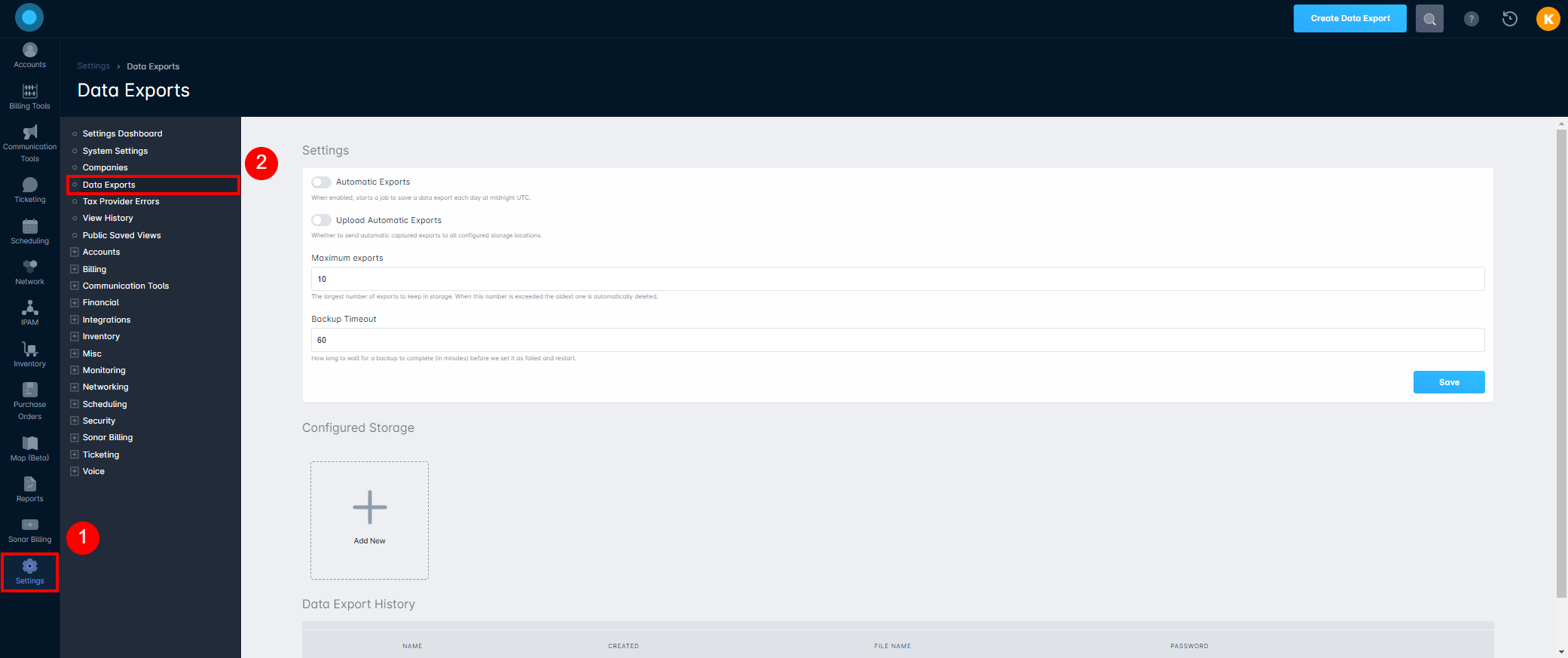
Below we'll review the information contained on this page, and what each section allows you to do.
Data Exports dashboard overview

- The Create Data Exports button allows you to manually initiate a data export which will be stored on the instance, available for download on demand

- The Automatic Exports toggle allows you to tell your instance that you would like it to make backups of your data every night at midnight UTC
- The Upload Automatic Exports toggle allows you to tell the instance to send the backups to your configured storage (see step #5)
- The Maximum exports value allows you to set the maximum number of exports preserved on your instance. Any more than this set value will be removed to make room.If you're using configured storage, this maximum limit will also apply to those locations.
- The Backup Timeout value allows you to define the amount of time (in minutes) an export should run before it is considered to be failed.
- The Backup Timeout value must be set between 60 and 1440 minutes (1 to 24 hours)
- The Default value is set to 60 minutes
- If the data export is running for longer than the set value, it will be marked as failed and restartedIf you're finding that all of your data exports are failing, it may be worth increasing the timeout before contacting support.
- The Configured Storage section allows you to add an off-instance location for your exports to be duplicated to. You have the following options for providers:When configuring your external Data Export Storage, your provider may require that Sonar's Egress IP Address be whitelisted. For the most up-to-date list of IP Addresses, you can review the Sonar IP Addressing article.
As information can flow between IP Addresses interchangeably, ensure that all addresses are whitelisted.- Amazon S3
Amazon S3 credential requirements
1. Your AWS S3 account key
2. Your AWS S3 account secret
3. Your AWS S3 region
4. The AWS S3 API version
5. Your AWS S3 bucket
6. The base path for storing the data exports in your S3 instance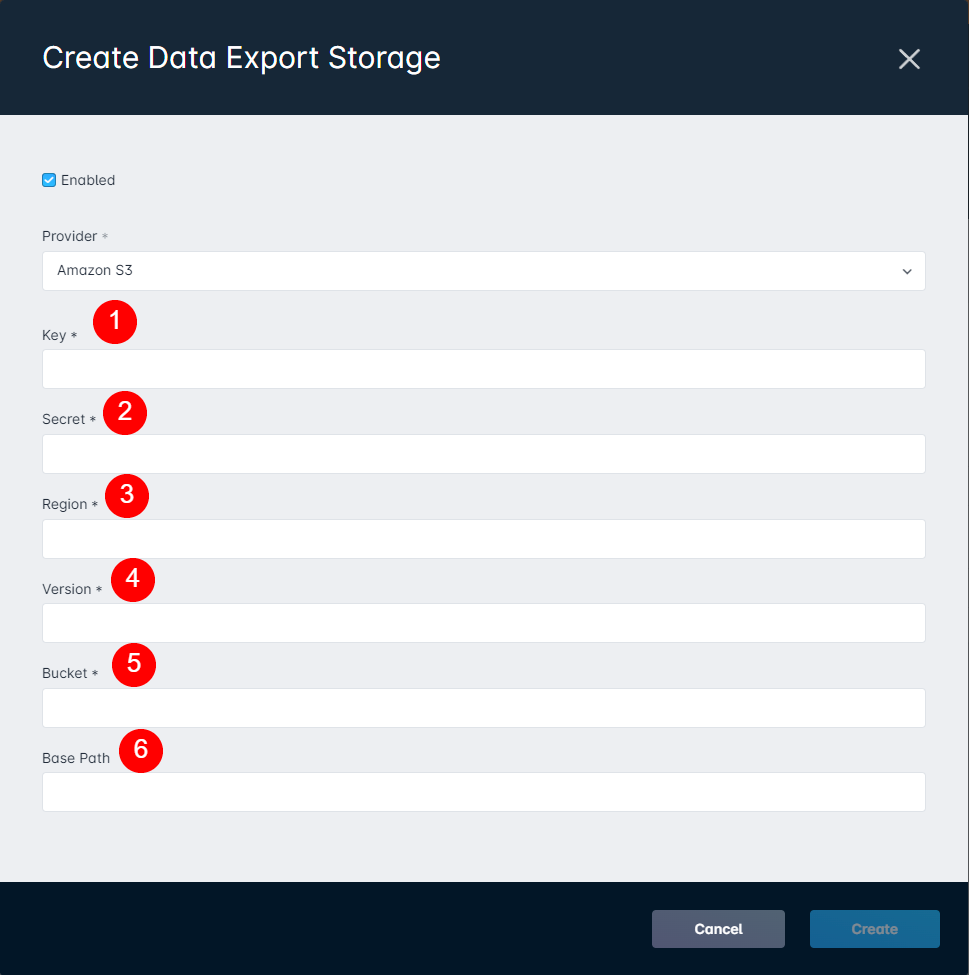
- Azure Blob Storage
Azure Blob Storage credential requirements
1. Your account name
2. Your account key
3. The container name
4. The base path for storing the data exports in your Azure Blob Storage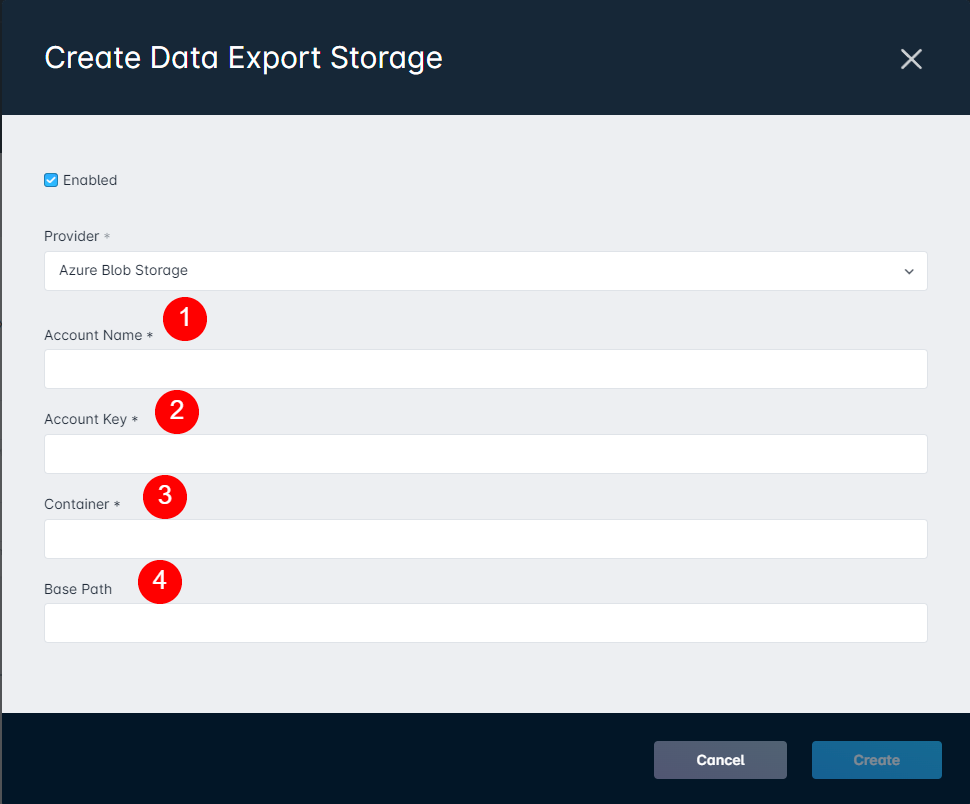
- DigitalOcean Spaces
DigitalOcean Spaces credential requirements
1. Your DigitalOcean Spaces account key
2. Your DigitalOcean Spaces account secret
3. Your DigitalOcean Spaces region
4. The DigitalOcean Spaces API version
5. The DigitalOcean Spaces endpoint
6. Your DigitalOcean Spaces bucket
7. The base path for storing the data exports in your DigitalOcean Spaces bucket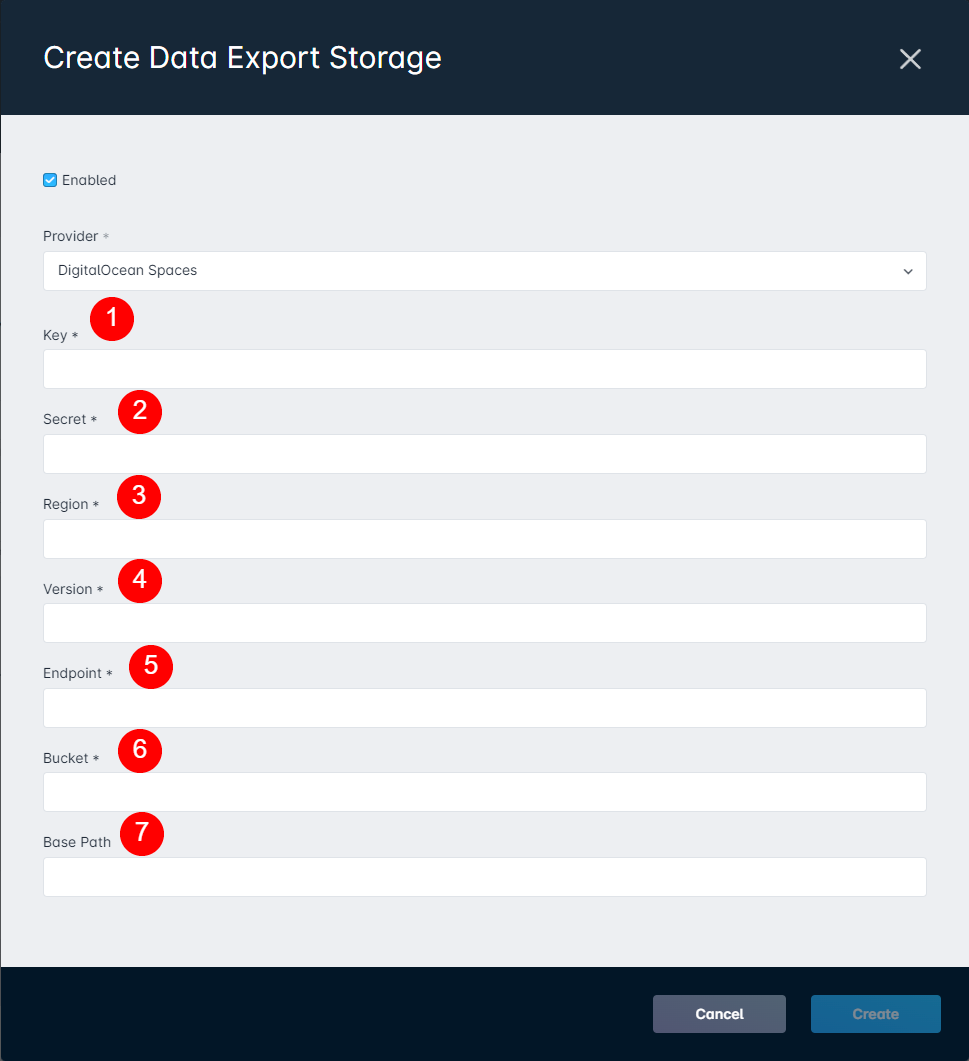
- Dropbox
Dropbox credential requirements
1. Your Dropbox account authorization token
2. The base path for storing the data exports in your Dropbox instance
- Google Cloud Storage
Google Cloud Storage credential requirements
1. Your Google project ID
2. The contents of your Google Cloud Storage key file
3. Your Google Cloud Storage bucket
4. The base path for storing the data exports in your Google Cloud Storage instance
- Rackspace
Rackspace credential requirements
1. The Rackspace identity endpoint
2. Your Rackspace username
3. Your Rackspace password
4. Your Rackspace region
5. The base path for storing the data exports in your Rackspace instance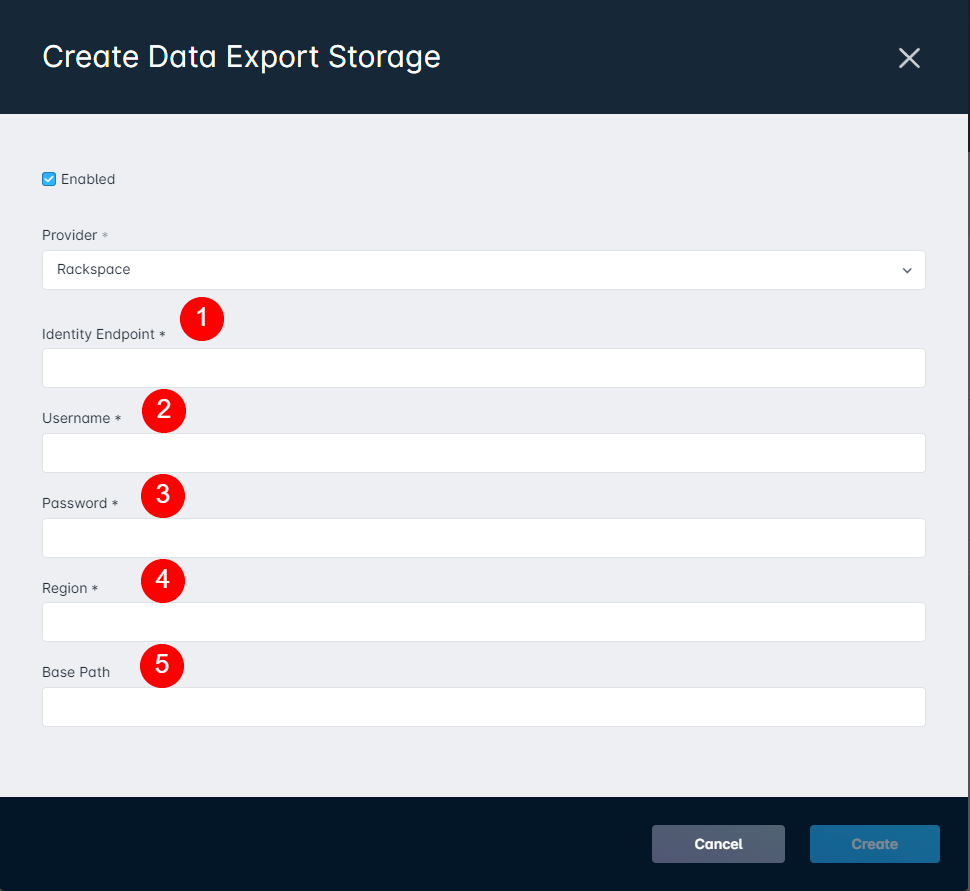
- Scaleway Object Storage
Scaleway Object Storage credential requirements
1. Your Scaleway Object Storage account key
2. Your Scaleway Object Storage account secret
3. Your Scaleway Object Storage region
4. The Scaleway Object Storage API version
5. The Scaleway Object Storage endpoint
6. Your Scaleway Object Storage bucket
7. The base path for storing the data exports in your Scaleway Object Storage instance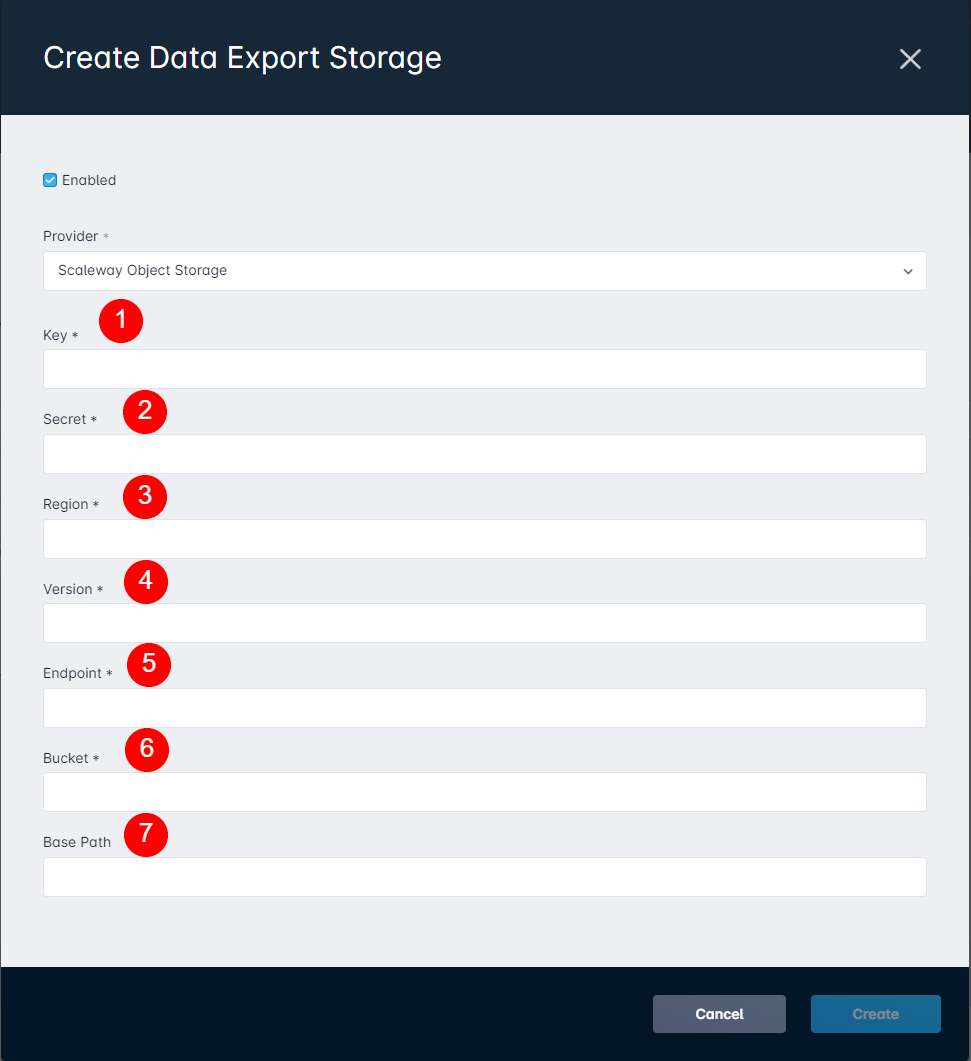
- SFTP
Secure FTP credential requirements
1. The host of the SFTP server
2. The port of the SFTP server
3. Your SFTP username
4. Your SFTP password
5. The base path for storing the data exports in your SFTP server
- Amazon S3
- The Data Export History table will display a history of all exports stored on your instance, up to the maximum selected. This table displays the data export name, when it was created, the file name, and the file password.
Using the Data Exports tool
In this section, we'll explore using the export tool in a few different scenarios, in order to make sure we have a firm grasp on how you can back up your Sonar instance data.
Running a manual data export
One of the simplest methods of using the Data Export tool is running a manual backup. This particular process requires only entering a name of the backup.
Manually creating a backup of your instance data is a quick and easy way of being able to take the information in Sonar and move it to another platform or 3rd party software.
Using Automatic Exports
Another method of using the Data Exports in Sonar is through enabling automatic exports. The Automatic Exporting is intended for use in situations where an external application may frequently need access to the customer data hosted in Sonar.
Configuring a Storage Location
The final method of using the Data Exports feature builds on the Automatic Data Export method covered in the previous segment.
Configuring a storage location allows you to add an external destination for all backups being made, as long as the Upload Automatic Exports toggle is enabled. Once enabled, exports will be stored on both the instance and on the configured storage location(s).
